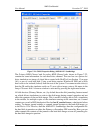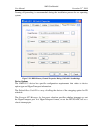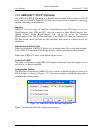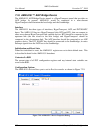
AMD Confidential
User Manual November 21
st
, 2008
96 Chapter 7: Device Configuration
7.12 PCI BUS Device
The PCI Bus device enables you to add PCI devices to the system. You can configure the
PCI Bus device to provide any number of PCI slots for one to six connections. You
configure each PCI slot on the PCI Bus by setting its device number and base IRQ-
routing pin.
Interfaces
The PCI Bus device has two types of interfaces, a bus interface and one or more slot
interfaces. The bus interface connects to a device that provides a PCI bus, such as a
Northbridge. Each PCI-slot interface is capable of connecting to a PCI device, such as a
PCI video controller.
The PCI bus behaves somewhat differently than other AMD SimNow devices. First, the
connection points are not all centered in the middle of the icon; instead each connection
point has a discrete location around the perimeter of the icon to provide a visual
indication that each PCI device is connected to a different PCI slot. Second, the
connection points are exclusive; that is, only one device can connect to each connection
point on the PCI bus, because in a real system one cannot install two PCI cards into a
single PCI slot. It is planned that these new behaviors will be used in other devices when
required.
Initialization and Reset State
The default state of the device has all slots disabled. This is because each platform
configures its PCI Buses in specific ways that make it impossible to provide a generic
default.
Since the PCI Bus device does not include any state that is altered during the course of a
simulation, after a reset, the PCI Bus device remains unchanged
Contents of a BSD
The configuration of the PCI bus, including which slots are enabled, the device ID for
each slot and the base IRQ-routing pin for each slot, and the connection points, are saved
in the BSD.
Configuration Options
Figure 7-25 shows the PCI-Bus configuration options.


















